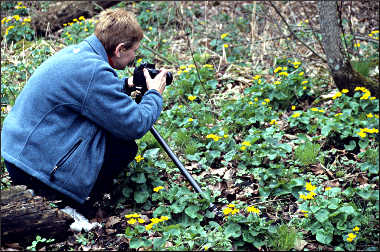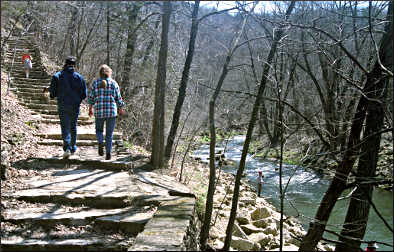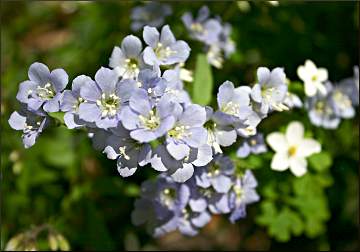Minnesota's spring mecca
In May, Whitewater State Park is the place to find trout, morels and wildflowers.

© Beth Gauper
In May, there's no better place to be than a park in the bluffs of southeast Minnesota.
Of course, May is beautiful everywhere. But Whitewater State Park has the best array of spring wildflowers, the best morel-mushroom hunting and the best trout fishing — or if it's not the best, at least there's none better.
"I wish we could have a year of Mays," longtime park naturalist Dave Palmquist likes to say.
This deep bowl of a park, surrounded by limestone crags and chimneys, also is the best place to see golden eagles. Only one thing is missing in Whitewater: mosquitoes.
In this part of the state, porous limestone lies just under the surface. Rain goes right through it and into cold, fast-moving underground streams.
Brook trout like it, but mosquitoes don't. There's no standing water, so there's nowhere for them to breed.
The trout congregate around the cold headwaters of the spring-fed Whitewater River, named not for rapids but for the chalkiness it acquires in spring, when bits of limestone bluffs erode into it.
Schools of fly fishermen descend on the park when trout season opens in April. Anyone can learn how to cast a line at the park's free Intro to Trout Fishing programs and the state's $7 I Can Fish programs.
The first time I visited Whitewater, a score of fishing students were swishing lines through the air and listening to their instructor as intently as if he were teaching a class in rocket science — which, judging from his talk about speed and trajectory, he may as well have been.
Fishermen lined the Whitewater River but weren't having much luck. Nearby, I started to follow a trail along Trout Run Creek, where I saw maybe 40 trout in the crystal-clear water.
It was hard to count because they were darting around so quickly; perhaps they'd heard the grinding of reels nearby.
I didn't tell on them and walked farther along the trail, through the flood-plain forest on the valley floor.

© Beth Gauper
Devastating floods started after early settlers cleared the valley's steep slopes for grazing. In 1938, the farming town of Beaver, eight miles north of the park, flooded 28 times and was abandoned. Today, it's buried by topsoil.
Conservation efforts began to restore the valley in the 1940s, and now it is home only to golden eagles, timber rattlesnakes and wild turkeys — and campers, of course.
The lack of mosquitoes makes Whitewater very popular for camping in summer, and there's a swimming beach on a lake created out of a bend in the river.
Whitewater also is a great place to hike, with 10 miles of trails. The favorite is a short loop that leads up to Chimney Rock, a craggy pillar that overlooks the valley floor.
The best is the four-mile Dakota Trail, where you'll have spectacular views from three overlooks on craggy blufftops.
The easiest is the two-mile Meadows Trail, on which hikers can look up at 200-foot cliffs; that view is nearly as good.
For a spring wildflower walk, park naturalists recommend the trail through the cart-in campground to the river, which is lined with every kind of woodland flower.
Among them: wild ginger, toothwort, marsh marigold, bloodroot, Dutchman's breeches, Jack-in-the-pulpit and false rue anemone, which turns the forest floor white.
The park is just as colorful in fall. Its oak- and maple-covered hillsides, punctuated by the occasional white pine, offer one of the Upper Midwest's best displays of late color, lasting until the end of October.
If you have a big group of friends, you can rent the park's cabins and lodge for $5 per person after Oct. 15. Dare we say it? It's the state's best deal.
Trip Tips: Whitewater State Park in southeast Minnesota
Getting there: It's 25 miles east of Rochester and six miles north of St. Charles.
Naturalist programs: Whitewater has a full-time naturalist, who organizes wildflower and morel walks, owl prowls and bird-banding programs.

© Beth Gauper
In the winter, there are snowshoe treks and golden-eagle spotting trips.
Cabins: Whitewater has a group center with eight heated cabins that sleep up to 132, a central bath facility and modern kitchen and dining hall with a wood-burning fireplace, $5 per person or a minimum of $130 from Oct. 15 to April 15 and $360 from April 16 to Oct. 14.
Groups also must pay for utilities. Call the park at 507-932-3007 a year in advance to reserve.
For more, see Cabins for a crowd.
The park also has five camper cabins, four of them for year-round use. Reserve up to 120 days in advance.
Camping: There are 104 drive-in sites and six walk-in sites. Walk-in site W4 is one of our 30 great campsites; it's next to the Whitewater River and against the bluff.
The rustic sites along the North Branch of the Whitewater River in neighboring Carley State Park are even more spectacular in the first half of May, when they're surrounded by thousands of bluebells and clouds of false rue anemone.